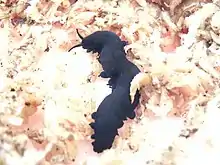Euperipatoides rowelli
Euperipatoides rowelli is an ovoviviparous species of velvet worm of the Peripatopsidae family. It is found in New South Wales and the Australian Capital Territory.[1][2]
| Euperipatoides rowelli | |
|---|---|
 | |
| Scientific classification | |
| Kingdom: | |
| Phylum: | |
| Class: | |
| Order: | |
| Family: | |
| Genus: | |
| Species: | E. rowelli |
| Binomial name | |
| Euperipatoides rowelli Reid, 1996 | |
Description
As all species in the genus Euperipatoides, E. rowelli has a dark grayish-blue color. Adult specimens measure about 3 to 5 cm in length, with females being larger than males. This species is characterized by two distinct rows of bristles on the antennal rings 4, 6, 9 and 12, while the remaining species of the genus have two distinct rows only on the two or four distal antennal rings.[3]
Ecology and Behavior
Euperipatoides rowelli occurs in humid, temperate forests of southeastern Australia. Its main habitat are decaying logs on the forest floor, where it lives in crevices and feeds on small invertebrates, such as termites and crickets.[4][5]
Specimens are rarely found alone, usually forming groups of a few individuals containing females, males, and juveniles. Laboratory observations on behavior concluded that these groups present some sort of hierarchy with dominant females.[5]
New logs are usually colonized by wandering males. The pheromones emitted by the first male to reach a log attract additional males, as well as females. It is assumed that males are attracted by other males because their high density increases the attraction of females.[6]
During reproduction, the male places its spermatophore on the female's skin. With the aid of the female blood cells, the body wall is breached and the sperm enters the female body cavity, then swims to the female genital tract. Females have two uteri and each one can have embryos at different developmental stages, up to six months apart, and from different males.[7] Males mature in about a year, while females can take up to three years.[8]
Model organism
Due to its abundance in its native habitat, E. rowelli is becoming a model organism in the study of behavior and ecology, and especially of gene expression and evolution, leading to a better understanding on the evolution of animals and especially arthropods, to which velvet worms are closely related.[9][10][11]
References
- "Australian Faunal Directory". Australian Government Department of the Environment. Retrieved 11 July 2016.
- Oliveira; Hering & Mayer. "Updated Onychophora checklist". Onychophora Website. Retrieved 13 July 2016.
- Reid, A. L. (1996). "Review of the Peripatopsidae (Onychophora) in Australia, with Comments on Peripatopsid Relationships". Invertebrate Taxonomy. 10 (4): 663–936. doi:10.1071/IT9960663.
- Barclay, S.; Ash, J. E.; Rowell, D. M. (2000). "Environmental factors influencing the presence and abundance of a log-dwelling invertebrate, Euperipatoides rowelli (Onychophora : Peripatopsidae)". Journal of Zoology. 250 (4): 425–436. doi:10.1111/j.1469-7998.2000.tb00786.x.
- Reinhard, J.; Rowell, D. M. (2005). "Social behaviour in an Australian velvet worm, Euperipatoides rowelli (Onychophora : Peripatopsidae)". Journal of Zoology. 267 (1): 1–7. doi:10.1017/S0952836905007090.
- Barclay, S.; Rowell, D. M.; Ash, J. E. (2000). "Pheromonally mediated colonization patterns in the velvet worm Euperipatoides rowelli (Onychophora)". Journal of Zoology. 250 (4): 437–446. doi:10.1017/s0952836900004027.
- Sunnucks, P.; Curach, N. C.; Young, A.; French, J.; Cameron, R.; Briscoe, D. A. (2000). "Reproductive biology of the onychophoran Euperipatoides rowelli". Journal of Zoology. 250 (4): 447–460. doi:10.1111/j.1469-7998.2000.tb00788.x.
- Curach, N.; Sunnucks, P. (1999). "Molecular anatomy of an onychophoran: compartmentalized sperm storage and heterogeneous paternity". Molecular Ecology. 8 (9): 1375–1385. doi:10.1046/j.1365-294x.1999.00698.x. ISSN 0962-1083.
- Franke, F. A.; Mayer, G. (2014). "Controversies Surrounding Segments and Parasegments in Onychophora: Insights from the Expression Patterns of Four "Segment Polarity Genes in the Peripatopsid Euperipatoides rowelli". PLoS One. 9 (12): 207–219. doi:10.1371/journal.pone.0114383. PMC 4255022.
- Franke, F. A.; Schumann, I.; Hering, L.; Mayer, G. (2015). "Phylogenetic analysis and expression patterns of Pax genes in the onychophoran Euperipatoides rowelli reveal a novel bilaterian Pax subfamily". Evolution & Development. 17 (1): 3–20. doi:10.1111/ede.12110.
- Franke, F. A.; Mayer, G. (2015). "Expression study of the hunchback ortholog in embryos of the onychophoran Euperipatoides rowelli". Development Genes and Evolution. 225 (5): 207–219. doi:10.1007/s00427-015-0505-4.
Further reading
- Schumann, I.; Hering, L.; Mayer, G. (2016). "Immunolocalization of Arthropsin in the Onychophoran Euperipatoides rowelli (Peripatopsidae)". Frontiers in Neuroanatomy. 10 (80). doi:10.3389/fnana.2016.00080. PMC 4972820.
- Strausfeld, N. J. (2006). "The organization and evolutionary implications of neuropils and their neurons in the brain of the onychophoran Euperipatoides rowelli". Arthropod Structure & Development. 35 (3): 169–96. doi:10.1016/j.asd.2006.06.002. PMID 18089068.
- Sunnucks, P.; Wilson, A. C. (1999). "Microsatellite markers for the onychophoran Euperipatoides rowelli". Molecular Ecology. 8 (5): 899–900. doi:10.1046/j.1365-294X.1999.00610.x. PMID 10368972.
- Treffkorn, S.; Mayer, G. (2013). "Expression of the decapentaplegic ortholog in embryos of the onychophoran Euperipatoides rowelli". Gene Expression Patterns. 13 (8): 384–394. doi:10.1016/j.gep.2013.07.004.
External links
- Friday Fellow: Rowell's Velvet Worm at Earthling Nature.